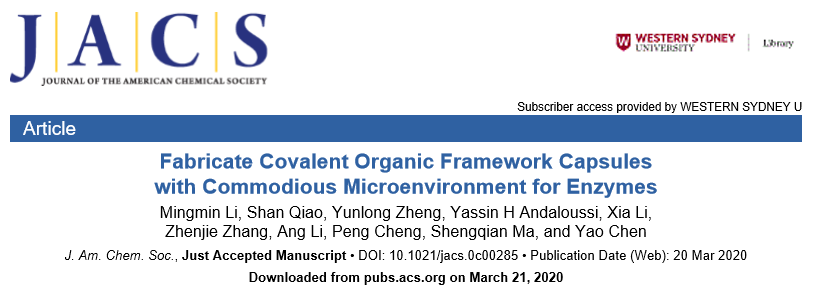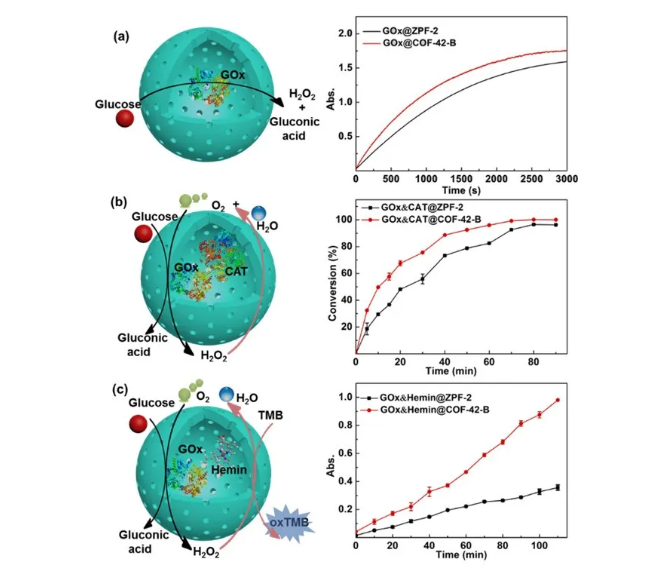Nankai uses MOFs as a sacrificial template to prepare COFs capsules as a new biologics platform
Recently, the research group of Chen Yao from the State Key Laboratory of Medicinal Chemical Biology and the School of Pharmacy of Nankai University used metal organic framework materials (MOFs) as sacrificial templates to prepare covalent organic framework materials (COFs) capsules that efficiently load biomolecules. In order to "untie" the biological macromolecules in the immobilized system, a new type of biologics platform that is easy to operate and customizable has been created. The work was published in the international academic journal "Journal of the American Chemical Society" (JACS). Li Mingmin, a doctoral student in the School of Pharmacy of Nankai University, is the first author of the paper.

According to reports, the capsule structure can not only effectively protect the enzyme from the external environment, but also give the enzyme in the inner cavity a higher degree of freedom. At the same time, the channel design of COFs effectively ensures the smooth mass transfer of the substrate. This method is not limited by the size of biological macromolecules, has strong universality, and is suitable for multi-enzyme cascade reactions. This research provides guidance for understanding the biocatalytic behavior of enzymes in vitro, and opens up a new path for the construction of artificial organelles, bioreactors, advanced microdevices and related biomedical applications.
Immobilization technology has become an effective way to promote the application of biological macromolecules. While exerting the protective power of limited space, maximizing the "fidelity" of the structure and activity of biological macromolecules is an urgent challenge in this field. However, traditional immobilized preparations have some shortcomings. For example, the performance of flexible biomacromolecules depends to a certain extent on their own degrees of freedom, and the low encapsulation rate, leakage, and mass transfer of the system are also key issues that plague this field and need to be developed. A new
immobilized preparation platform for the above problems.

Figure 1. Schematic diagram of the three-step method for preparing biomolecule @COF capsule structure
Inspired by the zoning effect common in living organisms, Chen Yao‘s research group took a different approach and proposed a new strategy of using MOFs as a sacrificial template to construct a confined space twice to prepare COFs capsules to encapsulate biological macromolecules. The porosity, high stability and adjustability of COFs make them an excellent carrier for immobilized preparations. However, the harsh conditions of its preparation process hinder its biomedical application. However, the use of porous materials to directly adsorb or wrap biological macromolecules is easy to imprison them, and the lack of freedom results in reduced activity and hindered mass transfer.
Chen Yao’s research group used ZIF-8 and ZIF-90, which are degradable under mild conditions, as sacrificial templates to release biomolecules without affecting their activity. First, MOFs were used to immobilize biomolecules, and then COFs were formed outside. In the outer shell, MOFs are finally degraded under mild conditions to "untie" the biomolecules and release them into the inner cavity of COFs, creating a customizable biomolecule @COF "core-shell capsule reactor" for the first time. And used to construct new biological agents and multi-enzyme cascade catalysis. Protected multi-subunit enzyme molecules (such as glucose oxidase and catalase) can be released into the larger outer COFs capsule, while protecting it, giving it a higher degree of freedom, and the structure and activity are maximized "fidelity" ", vitality increased by more than 300%.

Figure 2. Characterization of enzyme catalytic activity. (a) Using abts as the substrate, cyt c combined with colorimetric method to detect the activity of gox@zpf-2 and gox@cof-42-b; (b) measuring the degradation of glucose to characterize goxcat@zpf-2 and g
In order to explore the general applicability of the above preparation methods, Chen Yao‘s research group used a variety of MOFs and COFs materials to construct the capsule structure, and successfully controlled the internal cavity size and wall thickness of the capsule with good permeability. Tests prove that this strategy is also applicable to other biological macromolecules and multi-enzyme cascade systems (up to 80% increase in activity).
According to reports, the biomacromolecule protected by the crystalline capsule exhibits good stability and shows resistance to harsh conditions such as heat, organic solvents, proteases, and acids. In addition, after repeated recycling for more than 10 times, its activity is maintained.
Source Nankai University News Network
Paper link:
https://pubs.acs.org/doi/pdf/10.1021/jacs.0c00285
This information is from the Internet for academic exchanges. If there is any infringement, please contact us and delete it immediately
18915694570
Previous: "Science" Sub-Journal:


